 Benthic Ecogeochemistry Laboratory
UMR 8222
Benthic Ecogeochemistry Laboratory
UMR 8222
Concepts and practices in oceanography and marine biology: ecology
Concepts and practices in oceanography and marine biology: environment
Impact of anthropogenic on the functioning of coastal changes - UE 5UM17
Deep ecosystems and extreme marine environments - UE 5UM18
Master of Science of the Universe, Environment, Ecology
Speciality: Océanography and marine Environments (UPMC/SDUEE/OEM)
International Master of Science in Marine Biodiversity and Conservation
(ERASMUS Mundus EMBC+)
*********************************************************
3 weeks (6 ECTS)
Observatoire Océanologique de Banyuls-sur-Mer (http://www.obs-banyuls.fr)
Coordination : N. Le Bris, lebris @ obs-banyuls.fr , F. Lartaud, This email address is being protected from spambots. You need JavaScript enabled to view it.
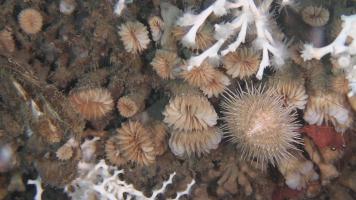
General objectives:
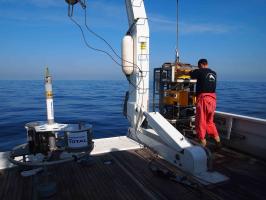
Unique biodiversity hotspots have been discovered on the ocean floor in a variety of extreme environments. While human pressures on the deep-sea are increasing, there is a great need for research and expertise to better assess the functions of these ecosystems and their sensitivity to disturbance. Defining effective conservative strategies however requires improving the knowledges of functional relationships between species and their environment. This interdisciplinary course introduces the current knowledge of the dynamics and functioning of model ecosystems from hydrothermal vents, submarine canyons or methane seeps, as well as generic features associated with deep-sea corals and organic falls. Lectures and seminars by international experts will focus ont the challenges of deep-sea research and conservation, highlight the most recent scientific issues and findings and the promises of novel experimental approaches and techniques (omics, in situ sensors).
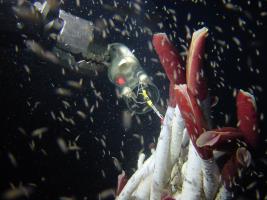
The ultimate aim of this course is to provide a comprehensive view of the biotic and abiotic drives and their interactions in deep-sea biodiversity hotspots, with special emphasis on the following points:
- Properties and distribution of deep-sea extreme environments
- Biological adaptations and deep-sea ecosystem functioning and dynamics
- Linkages between biogeochemical cycles and ecosytem functions in the deep-sea
- Recent advances in underwater technology and in situ approaches for deep-sea research
- Initiatives and challenges for the conservation of deep-sea biodiversity hotspots
Keywords:
1) Hydrothermal vents, cold seeps, canyons
2) Cold water corals, organic falls, sunken woods
3) Chemosynthesis and energy pathways
4) Geosphere and biosphere interaction
5) Adaptation to environmental extremes
6) Conservation of deep-sea biodiversity hotspots
7) Exploration, experimentation and observation
Initial competences:
Basics in biology and chemistry. background in marine sciences appreciated but not prerequisite.
Credits: 6 ECTS: Written exam (60/100). Bibliographic project (40/100).
Ecology of coastal communities - UE 5UM13
Master Science of the Universe, Ecology, Environment
Speciality Oceanography and Marine Environments
5MU13
****************************************************************
3 weeks (6 ECTS) - Observatoire Océanologique de Banyuls-sur-Mer (http://www.obs-banyuls.fr)
Responsible teachers : F. Lantoine, This email address is being protected from spambots. You need JavaScript enabled to view it. and J.-M.Guarini guarini @ obs-banyuls.fr
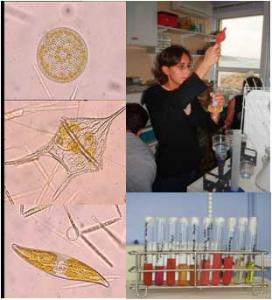 Ecosystems are complex systems composed of the biotic communities and its abiotic environment with numerous interactions. In order to understand how ecosystems function and persist it is necessary to know ecological communities are distributed and vary. Understanding the mechanisms that generate and maintain biodiversity, and more particularly the spatial distributions of taxa, is a key objective in ecology. This is also essential to predicting ecosystem responses to future environmental change. The complexity associated with communities is due in part, to the diverse interactions between many species at various trophic levels and their connections with their abiotic environment, making ecosystem -based studies difficult. In marine environment, coastal ecosystems are characterized by high biodiversity within a high complexity of the environmental factors interactions. They also are ecosystems strongly under the human impacts by pollution or alien species invasion constituting good models for communities' successions. Understanding how system function, requires a broad approach examining the distributions of communities and how species composition changes over time in relation to the biotic and abiotic environment.
Ecosystems are complex systems composed of the biotic communities and its abiotic environment with numerous interactions. In order to understand how ecosystems function and persist it is necessary to know ecological communities are distributed and vary. Understanding the mechanisms that generate and maintain biodiversity, and more particularly the spatial distributions of taxa, is a key objective in ecology. This is also essential to predicting ecosystem responses to future environmental change. The complexity associated with communities is due in part, to the diverse interactions between many species at various trophic levels and their connections with their abiotic environment, making ecosystem -based studies difficult. In marine environment, coastal ecosystems are characterized by high biodiversity within a high complexity of the environmental factors interactions. They also are ecosystems strongly under the human impacts by pollution or alien species invasion constituting good models for communities' successions. Understanding how system function, requires a broad approach examining the distributions of communities and how species composition changes over time in relation to the biotic and abiotic environment.
Course objectives
The main goal of the course is to introduce students to the theory and characterization of the processes that regulate, control and affect coastal communities.
This course will emphasis on both theoritical and practical approaches. After a general and theoritical reminder of marine' communities, and specificities of the coastal ecosystem, we'll try to define and illustrate the main factors wich control the establishment, evolutions and succession of communities. These will be applied on benthic and pelagic communities. In connection with the theoritical approaches, four main practical works (PW) will permit to illustrate and conceptualize some factors controlling the communities.
PW1: Effects of abiotic constraints on communities structure.
We will test environmental factors controlling the phytoplankton community structure and seasonal variations though photo-acclimation and -adaptation processes. This will allow us to illustrate bottom up structuring factors whit emphasis on individualistic traits (abiotic tolerance) of species and their interactions with the environment (niche requirements).
PW2 : Effects of biological interactions on communities structure.
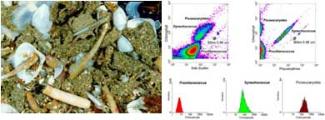
Experiment of filtering feeder on natural phytoplankton communities. This will allow us to show the direct and selective control of phytoplankton communities by benthic organisms. This predation process will illustrate a top down effect on community selection and the importance of bentho-pelagic coupling in coastal environment.
PW3 : Spatio-tempotal variability of communities
Experiment of colonization of benthic meiofauna on new rocky substrate will illustrate the primary successional changes in benthic communities, interactions and competition processes in colonization of space.
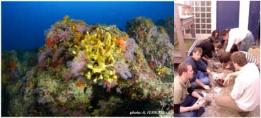
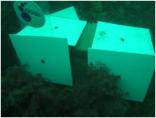
PW4: Interaction modelling
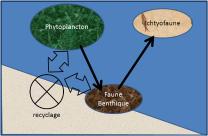
The design and construction of a simple model combinig the different factors controlling communities dynamic, will allow student to vizualize the communities interactions with external environmental factor and internal dynamic (predation/competition) processes spatial and temporal scales.
Notation :
6 ECTS : Written exam 50/100, bibliographic project 50/100
Notation
6 ECTS : Examen écrit 50/100, projet bibliographique 50/100
© 2026 LECOB



